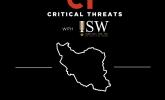Russian Offensive Campaign Assessment, November 19
November 19, 2022 - ISW Press
Russian forces are reportedly beginning to reinforce their positions in occupied Luhansk, Donetsk, and eastern Zaporizhia oblasts with personnel from Kherson Oblast and mobilized servicemen. The Ukrainian General Staff reported an increase in Russian military personnel in Luhansk City and noted that Russian forces are housing servicemen in abandoned homes in Krasne and Simeikyne about 30km southeast of Luhansk City. Luhansk Oblast Administration Head Serhiy Haidai stated that Russian forces are transferring the remnants of the Russian airborne units from right (west) bank Kherson Oblast to Luhansk Oblast. Luhansk Oblast Military Administration added that a part of redeploying Russian troops is arriving in Novoaidar, approximately 55km east of Severodonetsk. Advisor to Mariupol Mayor Petro Andryushenko also noted the arrival of redeployed personnel and military equipment to Mariupol, stating that Russian forces are placing 10,000 to 15,000 servicemen in the Mariupol Raion. Andryushenko stated that newly mobilized men are deploying to the presumably western Donetsk Oblast frontline via Mariupol. Russian forces are reportedly attempting to disperse forces by deploying some elements in the Hulyaipole direction in eastern Zaporizhia Oblast. Russia will also likely commit additional mobilized forces in the coming weeks, given that mobilized units of the Russian 2nd Motorized Rifle Division of the 1st Tank Army have finished their training in Brest Oblast, Belarus. Russian forces will likely continue to use mobilized and redeployed servicemen to reignite offensive operations in Donetsk Oblast and maintain defensive positions in Luhansk Oblast.







